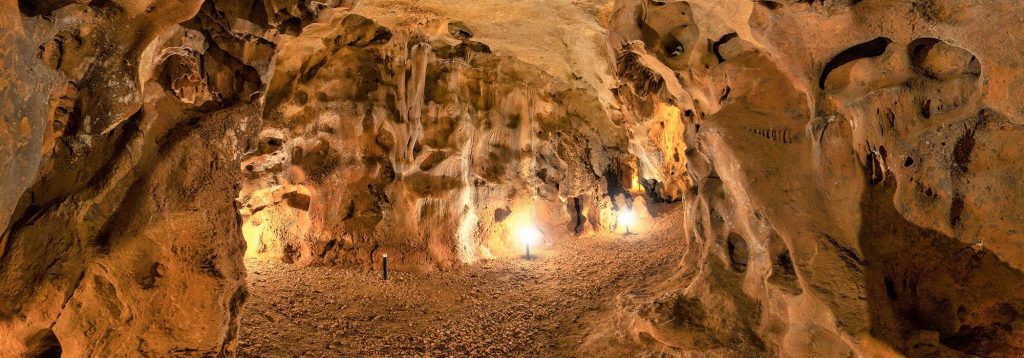
Without any exaggeration, we can proudly confirm that iwe have it all; you will find not only sun and beach, but also amazing caves in Malaga. The interior of the province has beautiful white villages, fantastic forests, national park and high mountain ranges where it even snows during the winter months.

You don’t necessarily have to be an experienced mountaineer or speleologist to delve into the depths of the earth, because first we are going to introduce you to the tourist caves in Malaga, all of them within a stone’s throw from the coast, with easy access and which you shouldn’t miss if you are on the Costa del Sol.
The second section is dedicated to people who love active tourism in Malaga, who want to discover these wonders hidden in the bowels of the earth.
Some of them require a higher level of preparation, but there are also a few that are ideal for beginners in caving with experienced instructors or simply to enjoy beautiful hiking or climbing routes… as you can see, it’s going to be difficult to choose!
Table of Contents
Caves in Malaga for general tourism
Cueva de Nerja
The Nerja Cave, also known as the “natural cathedral of the Costa del Sol”, is the most visited natural monument in Andalusia. It is situated only a short distance from Nerja and Frigiliana and is therefore a very popular tourist destination.
This extensive complex of natural underground galleries offers guided tours and every summer the famous Dance and Music Festival takes place inside the cave.
Approximately one third of the cave is open to the general public. The cave has one of the largest columns in the world, which is in the Guinness Book of Records. There is also an area with cave paintings about 40,000 years old restricted to research.
The Nerja Cave has a cloakroom, restaurant-cafeteria, gift shop, information office, photography service, car park, pedestrian path, children’s playground, picnic area, accessible toilets, breastfeeding room, botanical garden, landscaped areas, bus stops and cave tourist train (cave-museum route). Your essential visit if you are in Nerja.
Website and online tickets
How to get there
Cueva del Tesoro, Rincón de la Victoria

This cave with a name (Treasure Cave) that evokes stories of pirates, is located just 10 km from Malaga.
This cave is one of only three known caves of marine origin in the world, and is the only one of its kind on the European continent; the other two are in Asia and Central America (Mexico).
Numerous human, animal and ceramic remains from the period known as the ‘Neolithic of the Caves’ have been found in the cave through various excavations.
It is accessible for the whole family. There is a panoramic lift to go down to the chambers area. An audio guide is available.
Opening times: Winter (16 September to 14 June): 10 am to 1 pm and 3 to 5 pm.
Summer (15 June to 15 September): 10.30 am to 1 pm and 4.30 pm to 7 pm.
Admission: 4.65 €.
More information and tickets
How to get there
Cueva de la Victoria, Rincón de la Victoria
The hitherto closed Cueva de la Victoria (located just a few metres from Cueva del Tesoro) will open its more than 30,000-year-old cave to the public on 25 February 2022. In total there are two kilometres of galleries with paintings and engravings from the Upper Palaeolithic and Neolithic periods, as well as a large prehistoric archaeological site.
The guided speleological visits to these sites take place in small groups of ten people and last about two hours.
There are three visits a day: Fridays, Saturdays and Sundays at 10 am, 12.30 pm and 4 pm.
General admission: 16,50 €.
Tickets on the website of the town hall.
How to get there
Cueva Alta, Ojén
The upper cave of the village was used in the past as a shelter for livestock and has recently been beautifully restored to enjoy excellent views over the village and the Mediterranean Sea.
Caves in Malaga for hiking & speleology
Cueva de Ardales

The Cueva de Ardales or Cueva de Doña Trinidad is a cave about 1,5 km long and is situated 4 km from the village of Ardales and very close to the Guadalhorce reservoirs and the Caminito del Rey.
It was discovered in 1821 due to an earthquake which opened access to this cave and is still the access to it today.
The cave of Ardales stands out for its cave art dating back to 20 000 BC, as well as an important Neolithic site dating back to 3800 BC and also has impressive labyrinths of columns, permanent lakes and spectacular stalagmite formations.
In order to protect the rock art, access is restricted to a limited number of visitors (15 people). The guided tour lasts about two hours. Admission 15 €.
Opening hours: 10 am -1 pm Tuesday-Sunday, 4 -7 pm only on Fridays and Saturdays. Closed on Mondays.
More information and tickets at this link.
Cueva de la Pileta, Benaoján
The Cueva de la Pileta cave in Benaoján was discovered by chance in 1905. It is a prehistoric site with numerous paintings and engravings.
The cave consits on a series of galleries located at different levels and with heights of up to 15 metres.
It is necessary to book the entrance in advance. Admission 10 €. Group visits are for a maximum of 25 people and last approximately one hour.
You can make a reservation by calling +34 677 610 500 or by filling in this form.
Website
How to get there
Cueva del Gato, Benaoján
There is a second cave in the municipality, the Cueva del Gato. Unlike the Cueva de la Pileta, this one is particularly interesting for caving enthusiasts.
It is only possible to enter the cave with prior authorisation and the necessary equipment, to follow the route of an underground river. The system covers a total of 7,818 m and a difference in height of -219 m, with a main route of 4,500 m.
Note: At the moment, the Provincial Delegation of Malaga does not allow exploration by adventure companies.
Hikers can nevertheless enjoy the large waterfall and the crystal clear water pool, which even in the middle of summer is very cold. Because of these beautiful pools, the place tends to be too popular in the hot months.
It is easy to access and has a good car park. There are several places to stay nearby.
How to get there
Cueva del Hundidero, Montejaque
Although visitors can’t visit this cave, it is worth a visit to the village of Montejaque in Serranía de Ronda. Enjoy the newly landscaped surroundings of the Caminito de los Caballeros and the old abandoned dam (the clay soil made it impossible for the dam to store water).
The Cueva del Hundidero is surprising for the height of its entrance, some 50 metres above the ground.
Cueva de Belda, Cuevas de San Marcos

The Belda Cave is located in Sierra Falla del Camorro natural area with spectacular views and has impressive formations of stalactites and stalagmites.
Inside the cave there is a protected colony of bats, so the cave is not open to the public from the 1st of March until the 30th of September.
However, from hiking to rafting and climbing, Cuevas de San Marcos offers a wide range of activities regarding active tourism in Malaga.
Cueva de los Órganos, Mollina

In Sierra de la Camorra in Antequera there are more than thirty caves, this being the largest cave.
About a hundred metres deep and a kilometre long, this cave attracts many caving enthusiasts. It is an easy route with no technical difficulties, suitable for anyone with a minimum level of skill.
Expert speleologist monitors can guide you exploring this cave; the activity lasts around 3 hours.
Cueva de la Araña, Mollina
Mina de la Trinidad, Sierra de Mijas
Small panoramic circular route to the Trinidad Mine, one of the many in the Sierra de Mijas. Inside the mine we recommend to wear a mask because of the large amount of iron oxide in suspension which can cause discomfort.
Complete information about the route in GPS Malaga.
Cueva del Toro, Antequera
This cave, located in the spectacular natural setting of Torcal de Antequera at an altitude of 1,190 metres, was inhabited 7,000 years ago.
In order to visit it, it is necessary to contact the Torcal de Antequera Visitor Centre, which organises guided tours of the interior.
Cueva Las Grajas, Archidona

This cave is located just over a kilometre from the town centre of Archidona. Remains have also been found there which show that it was inhabited thousands of years ago.
To get to the grotto you have to take a short hiking route (Las Grajas circular path) or drive along a forest track. Very popular among hikers and climbers.
Boquete de Zafarraya, Alcaucín

This cave is in a spectacular setting at about 1,100 metres in the municipality of Alcaucín, bordering on neighbouring Granada.
Despite its short distance, just 1 km, this route is difficult due to the type of terrain and the difference in altitude to be overcome in such a short distance.
Description of the route on Wikiloc.
How to get there
Peñas de Cabrera, Casabermeja

Las Peñas de Cabrera are in a virgin forest, without any recreational area or established itinerary, we can enjoy a beautiful Mediterranean forest and discover this most important archaeological site of open-air paintings in Andalusia.
Cueva de las Excéntricas, Igualeja
The Cueva de las Excéntricas is part of a group of caves located in the municipality of Igualeja in the beautiful Genal Valley. This cave stands out especially for its stalagmites and is very popular among caving enthusiasts.
The cave is about 15 metres deep and around 200 metres long and has an easy level for beginners in the exciting world of caving, although it is advisable to go with specialists or with active tourism companies that provide all the necessary equipment for this type of activity.
In the natural environment of Igualeja you can do different activities such as caving, climbing, via ferrata, canyoning or hiking.
Cueva del Gran Duque, Casares

Sierra de la Utrera is a karstic massif with limestone formations very similar to the Torcal de Antequera just a few kilometres from the Costa del Sol in the municipality of Casares.
In the path of Canuto de la Utrera in Casares, there is a cave with guided access. In the area you can go climbing, hiking and caving. There are currently active tourism companies that provide guided tours of this and other caves in the area.
Cueva del Chamizo
In the upper Axarquia in the municipality of Villanueva del Rosario is this cave which is accessed by a demanding route.
The spectacular views will undoubtedly reward the effort.
There are also climbing routes in the area.
Description of the route on Wikiloc.
Active Tourism and Adventure Sports companies in Málaga
In the province of Malaga there are a large number of active tourism companies. There you can make your reservation for a guided expedition through the caves and get started in this exciting sport.
We list them in our article on Active Tourism and Adventure Sports in Malaga, where you can also find many more great ideas.
Interactive Map Caves in Malaga
In this interactive map you can see and consult all the places we have mentioned, with photos and opinions of other visitors.
















;) Top 10 archaeological sites in Malaga
Top 10 archaeological sites in Malaga;) Things to do in Malaga in February 2025
Things to do in Malaga in February 2025;) Boat rental in Malaga – Spend an unforgettable day offshore!
Boat rental in Malaga – Spend an unforgettable day offshore!